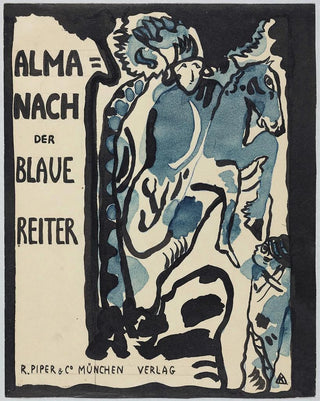Art print | Final design of the cover of the Le Cavalier Bleu almanac - Wassily Kandinsky


View from behind

Frame (optional)
The art print of the "Final conception of the cover of the Almanach Le Cavalier Bleu" by Wassily Kandinsky represents much more than a simple illustration. Indeed, this iconic work embodies the spirit of an era when art was liberating itself from traditional conventions to embrace a new vision of the world. Kandinsky, a major figure of the expressionist movement, captured the essence of human emotion through abstract forms and vibrant colors. The cover of this almanac, published in 1912, thus becomes an entry point into the complex and fascinating universe of modern art, while celebrating the meeting between art and music, a deep passion of the artist.
Style and uniqueness of the work
The style of this work is characterized by a bold use of color and geometric shapes, which blend harmoniously to create a striking visual balance. Kandinsky, as an innovator, transcended figurative representation to focus on the pure expression of emotions. The cover features circles, lines, and shapes that seem to dance across the paper, evoking a visual symphony that resonates with the soul. The vibrant hues, ranging from deep blues to bright yellows, testify to an ongoing search for beauty and a desire to provoke an emotional reaction in the viewer. Each element of this composition is carefully thought out, revealing a depth that invites interpretation and contemplation.
The artist and his influence
Wassily Kandinsky, born in Russia in 1866, is often considered the pioneer of abstract art. His artistic career is marked by a quest for spirituality and harmony, influenced by his studies in music and his passion for theosophy. Kandinsky believed that art should transcend the visible to touch the heart and mind. His influence extends far beyond his own artistic production, inspiring generations of artists to explore abstraction and push the boundaries of creativity. Through movements such as the Blaue Reiter, of which he was a founder, he helped redefine

Matte finish

View from behind

Frame (optional)
The art print of the "Final conception of the cover of the Almanach Le Cavalier Bleu" by Wassily Kandinsky represents much more than a simple illustration. Indeed, this iconic work embodies the spirit of an era when art was liberating itself from traditional conventions to embrace a new vision of the world. Kandinsky, a major figure of the expressionist movement, captured the essence of human emotion through abstract forms and vibrant colors. The cover of this almanac, published in 1912, thus becomes an entry point into the complex and fascinating universe of modern art, while celebrating the meeting between art and music, a deep passion of the artist.
Style and uniqueness of the work
The style of this work is characterized by a bold use of color and geometric shapes, which blend harmoniously to create a striking visual balance. Kandinsky, as an innovator, transcended figurative representation to focus on the pure expression of emotions. The cover features circles, lines, and shapes that seem to dance across the paper, evoking a visual symphony that resonates with the soul. The vibrant hues, ranging from deep blues to bright yellows, testify to an ongoing search for beauty and a desire to provoke an emotional reaction in the viewer. Each element of this composition is carefully thought out, revealing a depth that invites interpretation and contemplation.
The artist and his influence
Wassily Kandinsky, born in Russia in 1866, is often considered the pioneer of abstract art. His artistic career is marked by a quest for spirituality and harmony, influenced by his studies in music and his passion for theosophy. Kandinsky believed that art should transcend the visible to touch the heart and mind. His influence extends far beyond his own artistic production, inspiring generations of artists to explore abstraction and push the boundaries of creativity. Through movements such as the Blaue Reiter, of which he was a founder, he helped redefine






